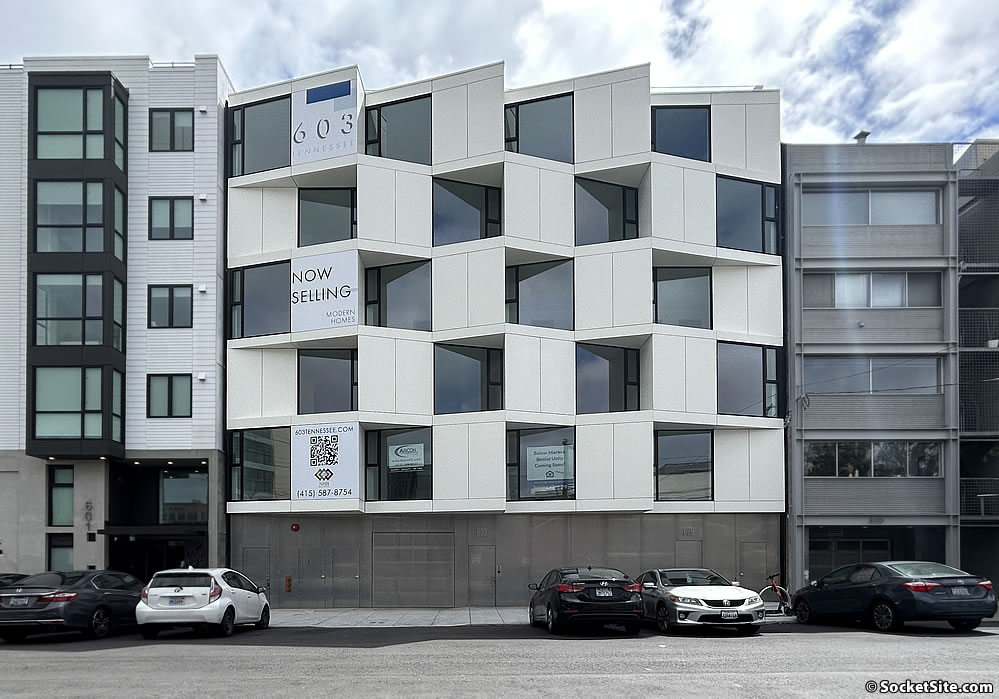With the financiers of the finished 25-unit development which is sitting vacant at 603 Tennessee Street, across the street from UCSF’s Mission Bay Campus, a block from Chase Center and a short walk from the commercial corridors of both Dogpatch and Mission Bay, moving to foreclose, the development team has declared bankruptcy, postponing the calendared foreclosure auction(s).
At the same time, the asking price for the roughly 20,000-square-foot development, the units of which could be “leased immediately or re-designate[d] as condominiums,” as previously mapped, has just been further reduced to $16.5 million or just over $800 per square foot, down from $18.995 million earlier this year with an interim reduction to $17.995 million last month and the opening bid for the postponed foreclosure auction having been set at just over $15 million. We’ll keep you posted and plugged-in.

This could be an opportunity for UCSF to purchase at a discounted price and provide needed housing for students/visiting professors?
In case you missed my mention of the project last month, UCSF already has a project underway to add additional units of student housing. The Academe at 198 will open a little later this Summer, and is planned to house students and trainees from University of California San Francisco as well as UC Law San Francisco (nee: University of California, Hastings College of the Law), San Francisco State University, University of San Francisco and other colleges and universities across the Bay Area in a so-called “academic village”.
Sure, this neighboorhood would be closer to UCSF’s Mission Bay Campus and perhaps less gritty than the Mid-Market/Tenderloin neighborhood around The Academe at 198, but the massive, dense apartment complex (14-story, 650 apartments) nearing completion at 198 McAllister St would be a much more cost effective housing solution than these 25-units and is only a little over a half-hour bus ride away.
How does the auction process work? What if nobody bids the min amount?
I have no particular legal expertise in this area, but I imagine that the administrator of the bankruptcy estate will have the ability to lower the minimum until credible bids are submitted. Unlike owners who sometimes unreasonably hold out for some wished-for amount, the administrator of the bankruptcy estate has the responsibility to maximize recovery for the creditors, and something < $16.5 million is better than nothing. I don’t know offhand how much time they usually get to resolve things, however.
It’s complicated but colorful…
I can’t imagine how many times that garage gets blocked.
I had the same thought. They’re going to need pavement markings or something to make it clear that it’s a driveway, or it’s going to happen constantly. Making the garage door inconspicuous probably seemed like great design to the architect.
Oh common, it’s not that hard to spot a curb cut and then notice a garage door.
If you’re looking for a curb cut, yes. But many people look for other cues like a garage door or concrete drive. I used to have a dirt driveway which was sometimes blocked by a parked car. I’m sure those drivers would have parked elsewhere had they realized they were blocking a driveway.
The issue is that the curb is lower than standard so the cut is harder to see—that and the garage door design and material are flush with the surrounding wall.
Sale postponed to 07-18-23…
At less than $650k per unit, these would be a lot cheaper than other low income housing builds—how about the city buy it for low income housing (!)
You’re probably right about the construction economics, but of course the money to acquire this property would have to be just sitting around unspent in some city agency’s budget waiting on some development like this one to fail to sell. That’s not the way things work in the public sector.
Earlier this month, City officials announced that the city is buying five properties worth a total market value of $66.5 million with the expectation that they will be able to build more than 550 below-market-rate homes for low-income seniors, families and formerly homeless people. None of them were in Dogpatch, and I gather from the press release that the $66.5M amount doesn’t include the cost of construction or renovation as the case may be — work which isn’t projected to begin until 2026 at the earliest — “pending the availability of new gap financing sources.”
Those properties were selected in a competitive bid process earlier this yea by The Mayor’s Office of Housing and Community Development.
UPDATE: The asking price for the roughly 20,000-square-foot development has just been further reduced to $16.2 million with a buyer having yet to emerge.
The Bank is the proud new owner.
I half expected the sale to be postponed again. And now the real price discovery process will begin.